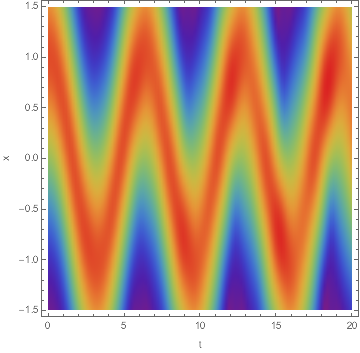Let's remember Schrodinger's equation:
$i\hbar\frac{\partial}{\partial t} \Psi(\mathbf{r},t) = \left [ \frac{-\hbar^2}{2\mu}\nabla^2 + V(\mathbf{r},t)\right ] \Psi(\mathbf{r},t)$
For the harmonic oscilator $V = x^2$, so your equation is missing a p[x,t] on the RHS besides the boundary conditions.
L also needs to be larger too. This seems to work.
w = 2;
L = 10;
c = 3;
usol = NDSolveValue[{I D[p[t, x], t] + 1/2 D[p[t, x], x, x] ==
1/2 w^2 x^2 p[t, x],
p[0, x] == Exp[(-w (x - c)^2/2)*(w/Pi)^(1/4)], p[t, L] == 0,
p[t, -L] == 0}, p, {t, 0, 10}, {x, -L, L}]
DensityPlot[Norm@usol[t, x], {t, 0, 10}, {x, -L/2, L/2},
PlotRange -> All, PlotPoints -> 100, ColorFunction -> "Rainbow"]
PlotRange -> All, PlotPoints -> 100, ColorFunction -> "Rainbow"]
update
For completeness purposes only, this is the solution with the abc boundary condition from @xzczd.
w = 1;
L = 3;
c = 1;
usol = NDSolveValue[{I D[p[t, x], t] + 1/2 D[p[t, x], x, x] -
1/2 w^2 x^2 p[t, x] == 0,
p[0, x] == E^(-w (x - c)^2/2)*(w/Pi)^(1/4),
\!\(\*SuperscriptBox[\(p\),
TagBox[
RowBox[{"(",
RowBox[{"0", ",", "1"}]Derivative[0, ")"}],
Derivative],
MultilineFunction->None]\)[t1][p][t, -L] - p[t, -L] == 0,
\!\(\*SuperscriptBox[\(p\),
TagBox[
RowBox[{"(",
RowBox[{"0", ",", "1"}]Derivative[0, ")"}],
Derivative],
MultilineFunction->None]\)[t1][p][t, L] + p[t, L] == 0},
p, {t, 0, 20}, {x, -L, L}]
DensityPlot[Norm@usol[t, x], {t, 0, 20}, {x, -L/2, L/2},
PlotRange -> All, PlotPoints -> 100, ColorFunction -> "Rainbow",
FrameLabel -> {"t", "x"}]
Note how in the first case the wave function starts to diffuse as time passes, so it's not really a coherent state.



